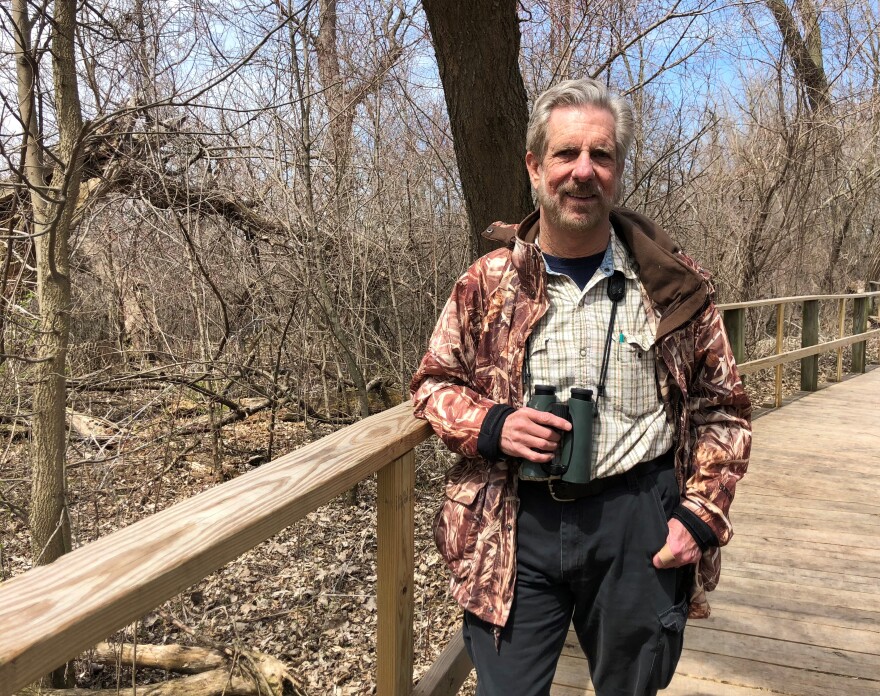A wetland along western Lake Erie’s shore is home to one of the world’s best spots for bird-watching. It’s also a hotspot for bird research.
This week’s Exploradio looks at the science and passion surrounding Ohio’s major migration stopover.
Even after decades of birdwatching all over the world, author and naturalist Kenn Kaufman still gets a kick out of spotting a tiny songbird close to home.
“A creeper! It’s a brown creeper!" he shouts in an excited whisper.

Kaufman points to the nearly invisible bird at the base of a tree.
"It’s like a piece of bark that’s come to life,” he says with the authority of someone whose life's work is creating pithy descriptions of birds.
Part of the thrill is that, like many of the birds we spot along the boardwalk that snakes through the Magee Marsh Wildlife Area, the creeper is just passing through.
A few steps farther, Kaufman spies another migrant.
“It’s a hermit thrush."
He points to another bark-like bird, "there running to the right.”
Our daily tally includes warblers, kinglets, rare ducks, wrens, swans, a woodcock, Virginia rail and other often hard to find birds all just hanging out within feet of the boardwalk.
Fans from all over the world
Kaufman says that’s what makes Magee Marsh such a great birding spot.
“You can talk to birders in Australia and they’ve heard about it. You can talk to birders in Germany and they’ve heard about it. Magee Marsh is famous among birders all over the world.”
It’s a remnant of the Great Black Swamp that once blanketed the northwest corner of Ohio.
Kaufmann says insects rising out of the wetland fuel the birds' last push north.
“Some of the birds that come through here are coming from Brazil and going to Alaska,” he says, with a few days layover on the Lake Erie shore.
In addition to thrilling birdwatchers, many of these birds are also adding to one of the country’s longest running migration research projects.
Measuring migrants
Ashli Gorbet is the banding projects manager at the Black Swamp Bird Observatory located at the entrance to Magee Marsh.

Gorbet catches birds in mistnets strung in an area of the marsh nestled behind the massive cooling tower of the nearby Davis-Besse nuclear plant, an area closed to the public.
The tools of her trade include a string of tiny metal bands and special pliers to crimp them around the toothpick-sized legs of songbirds.
Each band contains a unique tracking number. "It's a bird's Social Security number," she says.
Gorbet logs data from each bird during the month-long migration season. She notes its species, gender, wing length, and fat and muscle ratios, a measure of its readiness for travel.
“We actually blow across the feathers of the breast of the bird to part the feathers and see the skin," says Gorbet.
"You can actually see the fat, as an orangish-yellow color and the muscle looks red, like muscle.” Both are important for flying over the lake and onto Canadian breeding grounds.
It’s the largest bird-banding operation in North America.
“We have 30 years’ worth of data of every bird that we’ve banded," says Gorbet, "over 200,000 individuals.”
The miracle of migration
The banding program was started in 1978 by Black Swamp Bird Observatory Research Director Mark Shieldcastle, who’s spent his career studying bird migration.

“I developed the wave theory in the 90’s from that work," says Shieldcastle, "where these birds are coming through in waves."
A wave of birds is an association of species that are migrating at the same time. Shieldcastle says birds are imbued with precise internal clocks that tells them when to take flight.
“Every one of these birds are programmed by length of day," says Shieldcastle, "that’s what changes their hormonal actions and everything. Even near the Equator, they can pick up on minute changes in day length.”
He says migration is a risky time for a tiny bird traveling thousands of miles.
“For most of all these small birds, 80 percent of mortality is believed to occur during migration," says Shieldcastle. "So having good, consistent stopover habitat like what Ohio has is highly important."
He says conserving habitiat is critical for migrating birds' survival. "That’s where you can make a difference.”
And that difference includes educating the public about Ohio’s place in birds’ epic journeys, a topic close to the heart of big-time birder Kenn Kaufman.
“I’m not trying to make everybody into serious birders," he says, "but it’s such a miracle that this happens at all that I’d like people to get out and experience a little of it themselves.”
Kim Kaufman, Kenn's wife, is executive director of the Black Swamp Bird Observatory which hosts the annual Biggest Week in American Birding each May at Magee Marsh.











